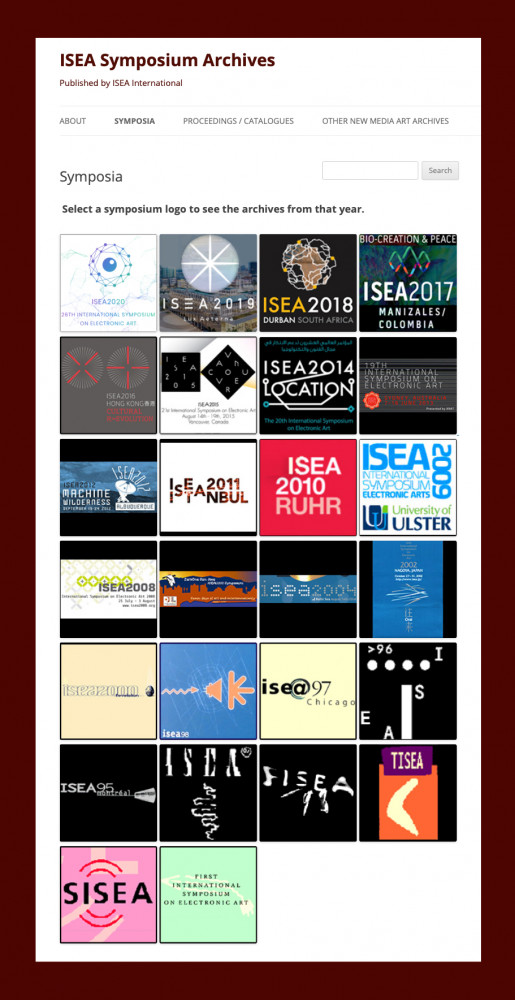
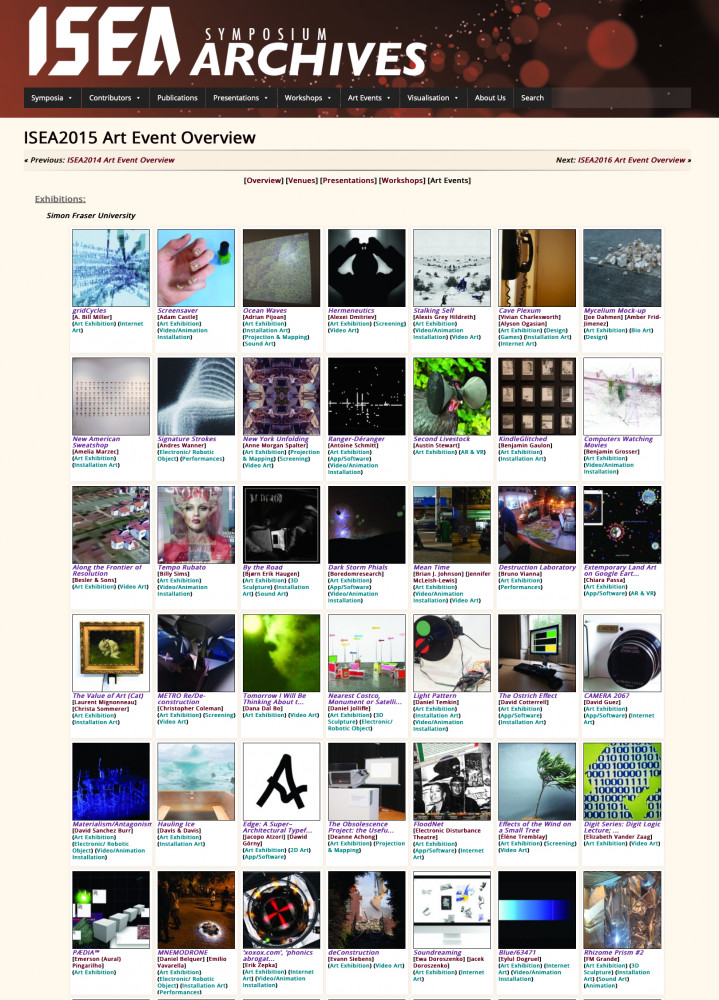
Wim van der Plas. Sociologist, co-founder and archivist of the International Symposium on Electronic Art. Archiving a Nomadic International Electronic Art Event.
ISEA was founded in 1988 by a sociologist interested in the relationship between art and science, Wim van der Plas, and a computer scientist, Theo Hesper. In contrast to Ars Electronica Festival, ISEA was conceived as an academic event. Its main characteristic is its nomadic nature: every year a different team organizes ISEA in a different city. The symposia, because of their one-time location, always manage to find their funding from subsidies and participation fees.
The co-ordinating organization (ISEA International) has no funding, except for a fee each symposium has to pay them; the board and the archivists work on a voluntary basis. The major disadvantage to the nomadism is that there has never been a systematic collection of the products of the symposia. In 2006 the Mondriaan Fund subsidized the creation of an online archive, currently existing in two versions: the classic version on a Wordpress web-page, curated by Wim van der Plas, and a new version curated by Bonnie Mitchell and Jan Searleman with the help of students and volunteers.
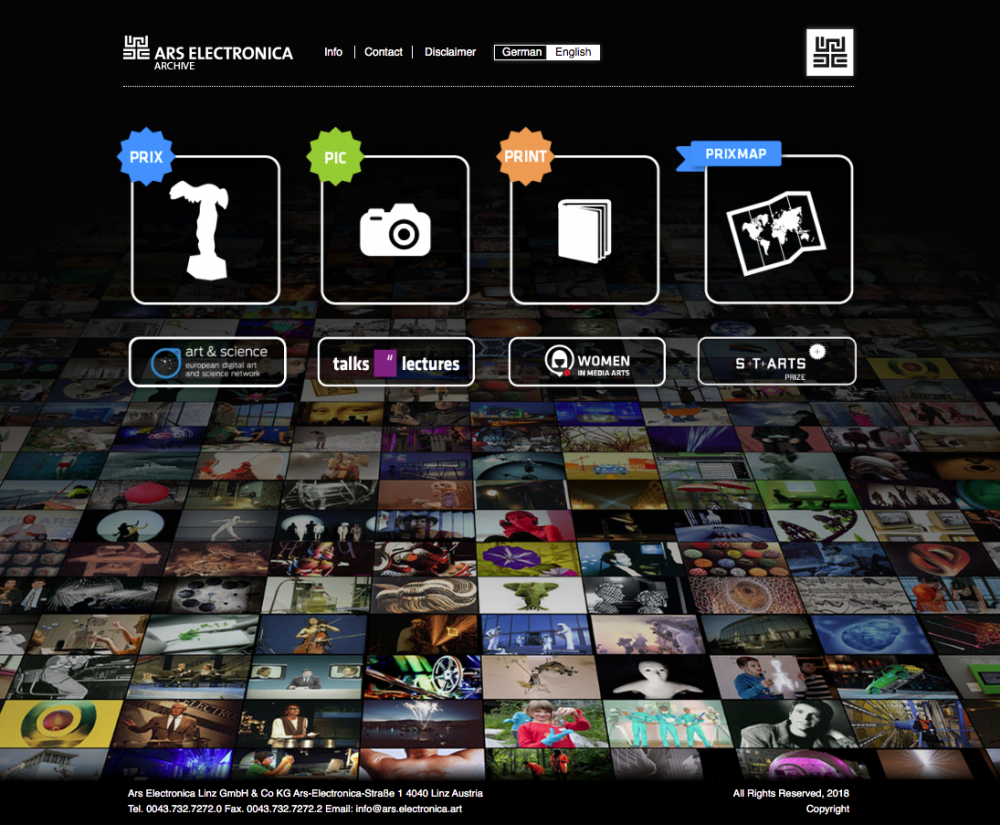 Michael Mondria. Managing Director of Ars Electronica Solutions. Re-Mapping the Archive.
Michael Mondria. Managing Director of Ars Electronica Solutions. Re-Mapping the Archive.
Ars Electronica was founded in 1979 and still preserves its original vision: the interaction of technology, art, and society. For more than four decades it has developed an organic institution comprising different facets: the Festival, the Prix, the Futurelab, the Archive and more.
The Ars Electronica Festival is held in Linz annually bringing the artists and scientists from all over the world for four days to discuss and create visions of what technologies will look like in the following 10-15 years. Each year there are around 1,600 artists and more than 10,000 visitors.
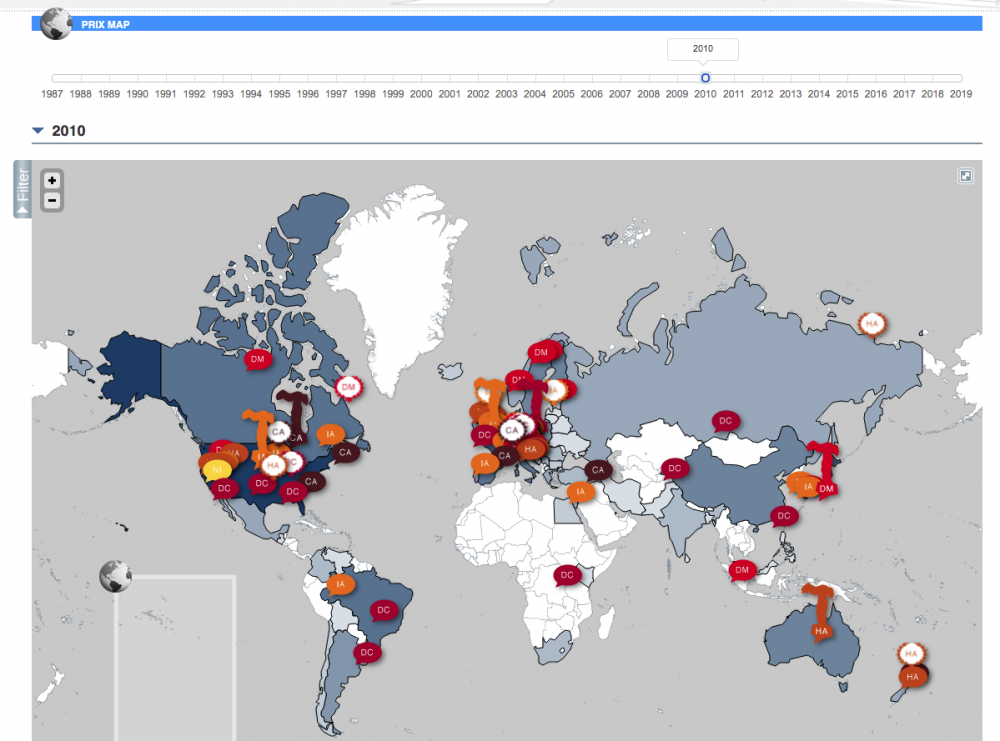 Ars Electronica Archive consists of the physical documentation of the media art projects presented at the Festival and a wide range of extra data, except for the software. The archive has gradually been digitized since 2001. This archive is available for research on a special request from universities and other academic institutions. Only part of that internal digital collection is available online. The selection is curated and showcases the winner projects from 1987 to 2020. Collections of pictures and print materials are also available, together with Prixmap: a visual geography of the artists who won Prix Ars Electronica. Another map represents female artists in media arts.
Ars Electronica Archive consists of the physical documentation of the media art projects presented at the Festival and a wide range of extra data, except for the software. The archive has gradually been digitized since 2001. This archive is available for research on a special request from universities and other academic institutions. Only part of that internal digital collection is available online. The selection is curated and showcases the winner projects from 1987 to 2020. Collections of pictures and print materials are also available, together with Prixmap: a visual geography of the artists who won Prix Ars Electronica. Another map represents female artists in media arts.
Yanina Prudenko, PhD, independent researcher and curator, founder and curator of the Open Archive of Ukrainian Media Art, and Anton Lapov, artist, independent curator and museologist, co-curator of the Open Archive of Ukrainian Media Art. Open Archive of Ukrainian Media Art. Archiving Ukrainian Media Art: Breakthroughs and Challenges.

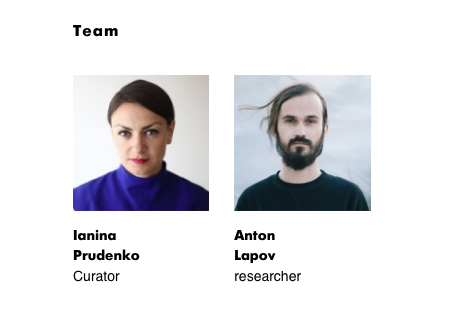
Despite the absence of any media art institutions in the Ukraine, its history dates back to the 1990s. In 2008 when Yanina Prudenko was creating an academic course on Ukaranian media art she found out that the history of its early years existed only in the oral form of anecdotes and VHS records. There was almost no secondary literature on the subject. In order to build a consistent narrative she had to conduct a series of interviews with artists and curators. She identified three independent stages in the Ukranian media art history. The first one began with the fall of the USSR when Ukranian artists were no longer ideologically restricted neither in media, nor in the subjects for their art. They eagerly picked up video technologies that were brought from the West.
In mid-1990s CCA Soros in Kiev and Odessa raised the first generation of the Ukranian digital artists by launching workshops, festivals and exhibitions of digital art. That proved to be a stillborn baby: when the organization curtailed its activities in the beginning of the 2000s, the Ukraine could no longer support media art events.
A new stage began in the late 2000s when a new generation of ‘digital natives’ grew up. The gaps between the generations could be explained by the lack of new media art educational institutions. The older generations simply couldn't pass their skills and knowledge on.
Yanina Prudenko started the Open Archive of Ukrainian Media Art in 2008 as a completely independent project. In 2013 the archive received a non-governmental grant to develop a website.
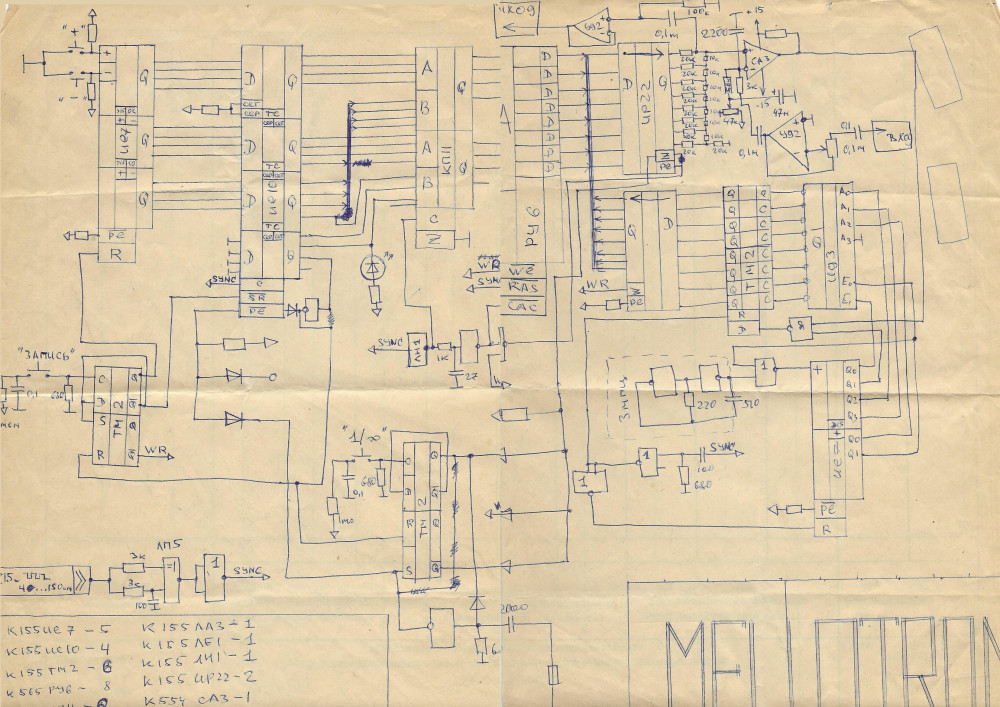
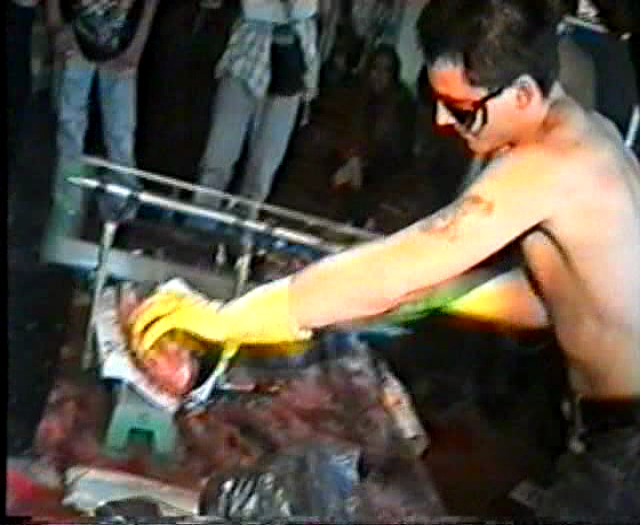 Anton Lapov focuses on methodological problems in the studies of Ukrainian media art which in global context is traditionally legitimized via the history of expansion of the CCA Soros in post-soviet countries. In particular, he considered this question through three connected optics: a) cultural and intellectual (self)colonization, b) questions of categorization and genre definition of technological сreation, c) question about methodology of research of “peripheral” art practices. The Open Archive of Ukranian Media Art for Lapov is a space of searching for answers to corresponding questions: a) “What is Ukrainian Media-Art”, b) “What is Media-Art?”, c) “What is art?”.
Anton Lapov focuses on methodological problems in the studies of Ukrainian media art which in global context is traditionally legitimized via the history of expansion of the CCA Soros in post-soviet countries. In particular, he considered this question through three connected optics: a) cultural and intellectual (self)colonization, b) questions of categorization and genre definition of technological сreation, c) question about methodology of research of “peripheral” art practices. The Open Archive of Ukranian Media Art for Lapov is a space of searching for answers to corresponding questions: a) “What is Ukrainian Media-Art”, b) “What is Media-Art?”, c) “What is art?”.
Rodrigo Guzman Serrano. Sound-artist, PhD candidate, School of Creative Media, City University of Hong Kong. Documenting and Archiving Digital Art and Web-based Art Resources: Two Models.
The model of web archiving at New York Art Resources Consortium (NYARC).
NYARC consists of the research libraries and archives of three leading art museums in New York: the Frick Collection, Brooklyn Museum, and MoMA. Web archiving is performed through Archive-It software and is aimed at making up 10 collections, thematic and institution-based. It is important to ‘harvest’ online content in order to capture the shifts in the production of content, to preserve unique interactive content that exists only online, and to provide bibliographic record.
On the example of archiving online content at moma.org the challenges of this process are outlined: capturing flash content and the problem of automated capture, which is very often inadequate, so for research purposes it is important that a human performs the archiving.
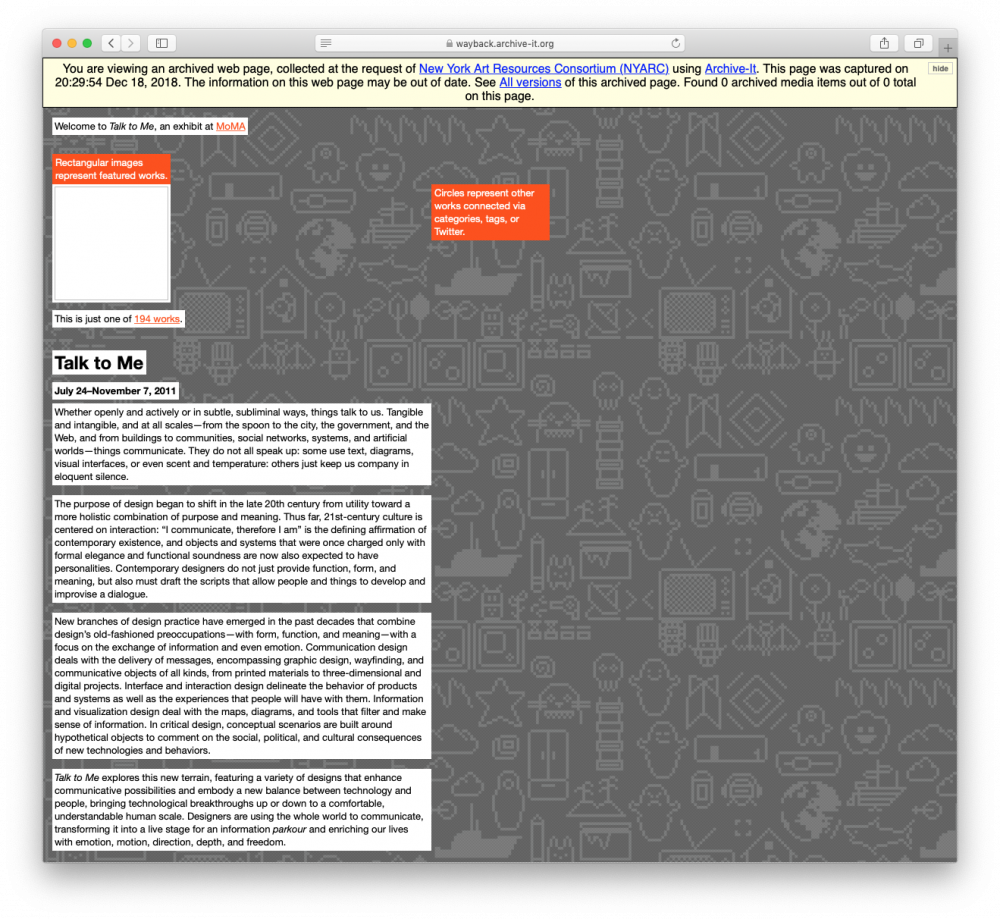
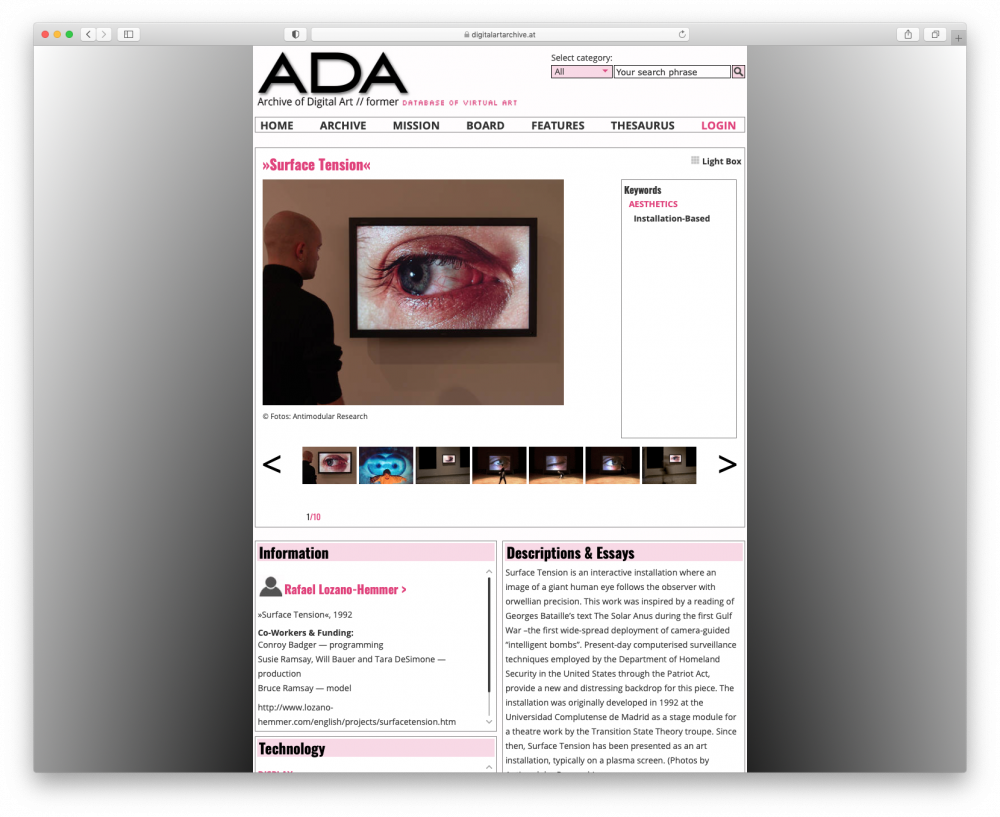
The second model is the Archive of Digital Art (ADA, formerly known as the Database of Virtual Art). Started in 1999 by Oliver Grau, it is one of the oldest archives in the field. The three main components are institutional profiles, artworks profiles, and personal artists’ profiles. The archive is similar to a social network, as the artists contribute to their pages themselves, and in itself is an art historical document.
Q&A session
Q (to all): What is your personal motivation for keeping the archive?
Wim van der Plas: Researchers and students of art. Michael Mondria: preservation and rescuing the digital artworks, the ideas, innovation and creativity of the past; media art is a barometer reflecting trends and status in technology.
Anton Lapov: Archiving is a space for contestation.
Rodrigo Guzman Serrano: Legitimization of the research field of digital art practices; a way of writing history.
Q (to R.Guzman Serrano and all): How do you keep track of the visitors? What is the average monthly number of visitors?
R. Guzman Serrano: ADA software does not keep track of the visitors automatically. As it is an academic project and a research tool, keeping track of visitors is not a priority.
W. van der Plas: Statistics is available at the website. Around 2,000 unique visits per month. There has never been a PR campaign for the archive. An initiative has been taken by Oliver Grau (ADA) to form a structural cooperation between ADA, ISEA, Ars Electronica, and SYGGRAPH. The network might potentially include other archives.
M. Mondria: Statistics of the online part of the archive is available at the website, but the bigger part is not available online.
Y. Prudenko: Statistics is available at the server.
Q (to W. van der Plas): What kind of personal data do you consider as relevant for artists and academics? Do you keep the same structure for all participants?
A: ISEA collects the bios that artists provide themselves. In the new version of the archive the artists are ascribed with the kind of art that they do (e.g. bio-art, robotic art, etc.), but such ‘putting people in boxes’ seems problematic.
Q (to W. van der Plas): How is the process of preparing material for catalogue organized?
A: As ISEA is a nomadic symposium, it is organized by a different group of people each time, and they do it in their own way. There is no standard way how a catalogue is compiled. Generally, it is based on the proposals submitted for the academic and the artistic parts of the programme.
Q (to M. Mondria): Is the artwork software included in the archive, and if so, how is it organized?
A: No, the artwork software is not included. The archive documents it in a very detailed way in conjunction with the artist, but does not store the code. The archive is not designed to recreate the artwork as it was.
Q (to Y. Prudenko and A. Lapov): What are your plans for the development of the archive? Are you looking for funds for the future growth?
A: The opening of the first institution in the field of contemporary art will soon take place. The archive hopes to be included in this museum. Even though there are a lot of opportunities for European research grants, the state funding is very important for long-term projects, such as the archive, and their sustainable development. At the moment the archive is working on a joint project with the initiative group involved in the creation of the Museum of Contemporary Art in Kiev.
Q (to R.Guzman Serrano): How does ADA monitor and moderate the pages filled by the artists?
A: There are a few ways. Anyone can apply, but not anyone can get in the archive. There is a panel that reviews that. Another way is that there are pre-determined keywords and you cannot invent your own genres. There are limitations in how you can tag your work. The last stage is editing, which is more like proofreading for mistakes.
Q (to W. van der Plas and M. Mondria): Do you keep the entries for the symposium and the festival that were declined?
W. van der Plas: The first two and the seventh symposia were held in the Netherlands and all that material was stored in Wim’s private house for a long time, at a certain point that had to be thrown away. As for the other 23, there have never been any rules on having to keep the materials. Not all organizers were able to save those, as ISEA has no means. The archive is for a major part a reconstruction of facts, and the researchers are constantly hunting for information and images of artworks from the first half of the ISEA history. The fact that it was not systematically saved presents a problem.
M. Mondria: All the submissions to Prix Ars Electronica are stored in a way. In the online archive you can see only 10 projects that were more or less awarded in certain categories, but not the hundreds of other projects that are stored in the archive but not accessible online.
By Sophia Abasheva
*Проект «Открытая база междисциплинарного искусства в России (МИР)» реализуется при поддержке Фонда президентских грантов.
